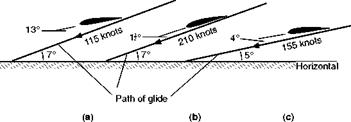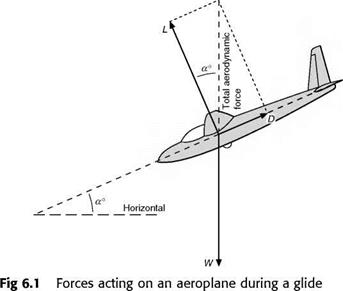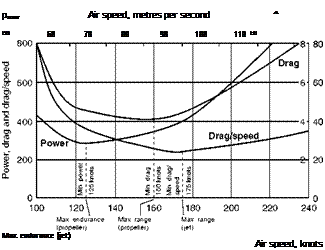By a process of simple geometry, it is easy to see that the angle formed between the lift and the total aerodynamic force is the same as the angle a between the path of the glide and the horizontal, which is called the gliding angle. Therefore
D/L = tan a
This means that the less lower value of D/L – i. e. the greater the value of L/D – the flatter will be the gliding angle.
From this simple fact we can very easily come to some important conclusions; for instance –
1. The tangent of the gliding angle is directly dependent on the L/D, which is really the ‘efficiency’ of the design of the aeroplane, and therefore the more ‘efficient’ the aeroplane, the farther it will glide, or, expressing it the other way round, the measurement of the angle of glide will give a simple estimate of the efficiency of the aeroplane.
The word ‘efficiency’ is apt to have a rather vague meaning, and we are using it here in a particular sense. We are concerned only with the success or otherwise of the designer in obtaining the maximum amount of lift with the minimum of drag, or what might be called the ‘aerodynamic’ merit of the aeroplane. For instance, our conclusion shows that any improvement which reduces the drag will result in a flatter gliding angle.
It will be noticed that this is the same criterion as for maximum range, so that an aeroplane that has a flat gliding angle should also be efficient at flying for range, neglecting the influence of the propulsion efficiency.
2. If an aeroplane is to glide as far as possible, the angle of attack during the glide must be such that the lift/drag is a maximum.
The aeroplane is so constructed that the riggers’ angle of incidence is a small angle of, say, 2° or 3°. This particular angle is chosen because it is the most suitable for level flight. As was explained when considering the characteristics of aerofoils, the modern tendency is to make this angle rather less than the angle of maximum L/D (because we are out for speed), but, even so, it will be within a degree or so of that angle, so it is true to say that the angle of attack during a flat glide will be very nearly the same as that during straight and level flight, and almost exactly the same as when flying for maximum range with piston engines.
The pilot finds it fairly easy to maintain ordinary horizontal flight at the most efficient angle because the fuselage is then in a more or less horizontal position. When gliding however, the task is not always so easy. Sophisticated modem aircraft may be fitted with an angle of attack indicator, but on older and simpler types this is not normally the case. Fortunately, as in level flight, there is a direct connection between the air speed and the angle of attack, and therefore the air speed can be found which gives the best gliding angle, and this acts as a guide to the pilot. The fact remains, however, that it requires considerable skill, instinct, or whatever one likes to call it, on the part of a pilot to glide at the flattest possible angle. This is the type of skill which is especially needed by the pilot of a motorless glider or sailplane.
It should be noted that, although there is a relationship between air speed and angle of attack on the glide just as there is in level flight, the relationship is not exactly the same, and the speed that gives the flattest gliding angle is usually rather less than the speed that gives maximum range. The difference, however, is small and the principle is the same.
3. If the pilot attempts to glide at an angle of attack either greater or less than that which gives the best L/D, then in each case the path of descent will be steeper.
Perhaps this conclusion may be considered redundant because it is simply another way of expressing the preceding one. It is purposely repeated in this form because there seems to be such a strong natural instinct on the part of pilots to think that if the aeroplane is put in a more horizontal attitude it will glide farther. Even if one has never flown it is not difficult to imagine the feelings of a pilot whose engine has failed, and who is trying to reach a certain field in which to make a forced landing. It gradually dawns on him that in the way in which he is gliding he will not reach that field. What, then, could be more natural than that he should pull up the nose of his aeroplane in his efforts to reach it? What happens? In answer to this question the student often says that he will stall the aeroplane. Not necessarily. He should in the first place have been gliding nowhere near the stalling angle, but at an angle of attack of only about 3° or 4°, so that he has many degrees through which to increase the angle before stalling. But what will most certainly happen is that the increase in angle will decrease the value of L/D and so increase the gliding angle, and although the aeroplane will lie flatter to the horizontal, it will glide towards the earth at a steeper angle and will not reach even so far as it would otherwise have done. The air speed during such a glide will be less than that which gives the best gliding angle.
Suppose, on the other hand, that, when a pilot is gliding at the angle of attack which gives him the greatest value of L/D, he puts the nose of the aeroplane down, this will decrease the angle of attack which, as before, will decrease the value of L/D and therefore increase the steepness of the gliding path, the air speed this time being greater than that which gives the best gliding angle.
It is not easy to visualise the angle of attack during a glide, and the reader, like the pilot, must be careful not to be confused between the direction in which the aeroplane is pointing and the direction in which it is travelling. It is hoped that the figures may help to make this important point clear (Figs 6.2 and 6.3, overleaf).
In the previous chapter we discovered that the ratio of lift to drag of complete aeroplanes may be in the neighbourhood of 8, 10 or 12 to 1. These values correspond to gliding angles of which the tangents are 1/8, 1/10 and 1/12, i. e. approximately 7°, 6° and 5° respectively. Thus, neglecting the effect of wind, a pilot will usually be in error on the right side if he assumes that he can glide a kilometre for every 200 metres of height, i. e. if he reckons on a gliding angle of which the tangent is 1/5.












 (g)
(g)






